
Phonetic spelling is an essential developmental milestone for any child learning the English language. Often adults overcorrect children’s “misspellings” without understanding the role that phonetic spelling plays.
This post includes a parent letter freebie for you to share with families, in order for them to understand how vital it is for children to use phonetic spelling when they're first learning to write. See if you can easily read it, since in true teacher fashion, I wrote it all phonetically.
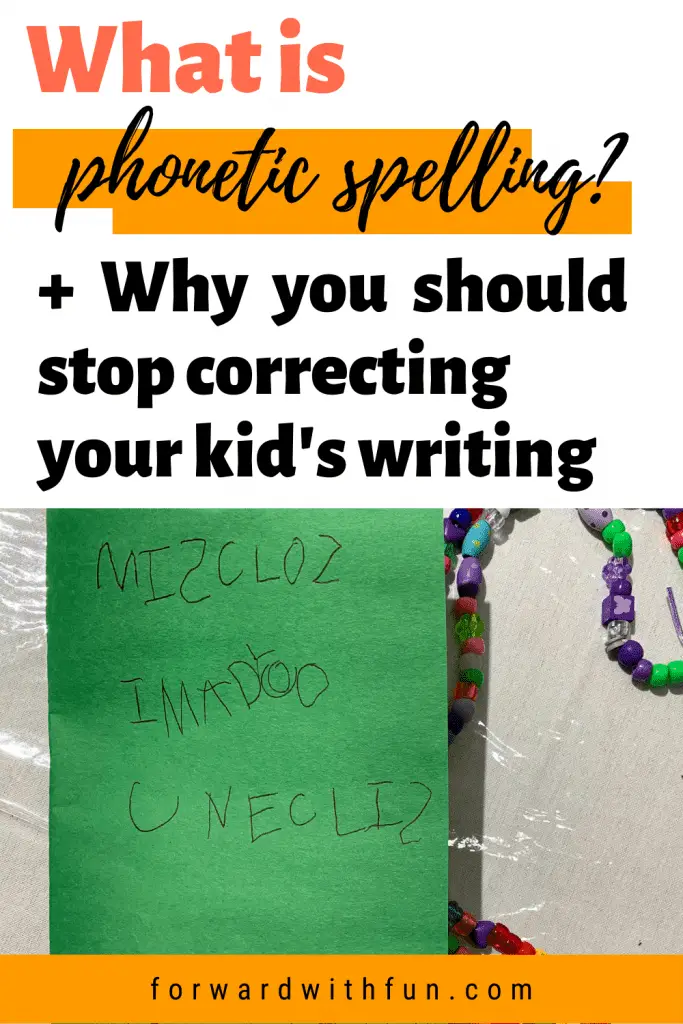
I’ve commonly called phonetic spelling, “kid spelling” in the classroom. Put in terms children understand, phonetic spelling is spelling words by sounding them out.
Sometimes phonetic spelling is referred to as inventive spelling, because children are creating spellings as they go - instead of spelling by memory.
When children are in pre-k and kindergarten, our focus is to teach them the letters and sounds of the alphabet. Each letter has a sound (or two). Children must master these sounds as the first step on their journey to becoming independent readers and writers.
Instead of classifying phonetic spelling as incorrect, I explain there are two kinds of spelling. One is adult spelling, and the other is kindergarten or kid spelling.
Guess what? Both are right. I've ruffled a few feathers on the internet by saying that, but if you keep reading, you’ll understand why.
When you see the following sentence written by a kindergartener, you’ll notice the words are all spelled incorrectly. Yet, if you read the phonetically spelled “words” out loud, you’ll be able to make sense of what was written.

"The flower is in my pocket." Well written, for a child or someone learning English for the first time! So you may have concluded by now that nope, English is not a phonetic language, unlike Spanish, German, and Polish.
The English language has many words that don’t sound as they are spelled: though, knife, far, raspberry, eight, to name a few.
Additionally, English contains many digraphs (ie. sh, ph, wh, ch). That combined with totally silent letters makes it a challenging language to learn.
Don’t even get me started about sight words like do, is, you. And then come the vowels with many different rules, like i before e, vowel teams, silent e, etc.
There are so many rules, that even I, someone who teaches phonics all day, don’t know them all!
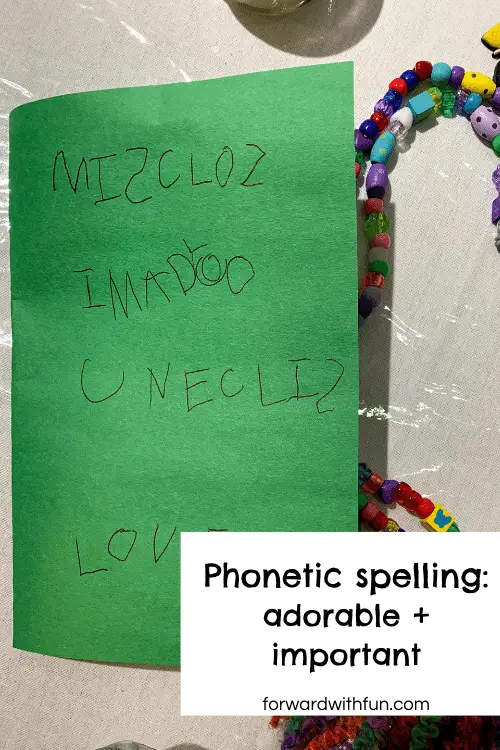
As a parent you might be thinking, “If I don’t correct this spelling, my child will learn how to spell everything incorrectly.”
I understand why people think that! But imagine this: you’re a young child who has no concept of reading and has just learned your alphabet.
After using the alphabet sounds you have been mastering over the last year (20% of your life!) you manage to sound out the word BOT (boat) only to be corrected and told it is in fact, BOAT.
What? This doesn’t make sense!
When we correct children’s spelling of words they have never been taught to spell, they may become discouraged and feel as if they’re not good at writing. After all, they learned their letters, and now the letters are not all they need!
When we encourage them to use phonetic spelling, we are reinforcing all that letter/sound knowledge. Additionally we are opening the doors for them to write without the help of an adult. This is going to create many opportunities for practice and feelings of ownership over their own writing.
I’d much rather that students spell things incorrectly and feel good about the task of writing than shut down and fear writing because they want to make sure everything is spelled like an adult.
Well, no. That doesn’t make sense either.
The spelling you should correct:
If your kid doesn’t know that a silent e makes the vowel “say it’s name,” then you wouldn’t need to tell them that they need an “e” at the end of “make.”
If your child has learned “is” and “of” as their sight words-which are memorized, then they should be spelling them correctly.
So when they learn a new spelling pattern or rule, those are now words that we can encourage them to spell with adult/standardized spelling.
For the rest of the words, encourage and praise phonetic spelling!
This way, we are reinforcing the alphabetic principle, that letters represent spoken sounds. This is also why in kindergarten, focus on teaching phonetically spelled CVC words: cup, kit, mat, bug, etc. These words make sense to children, and they’ll have more success when spelling them.
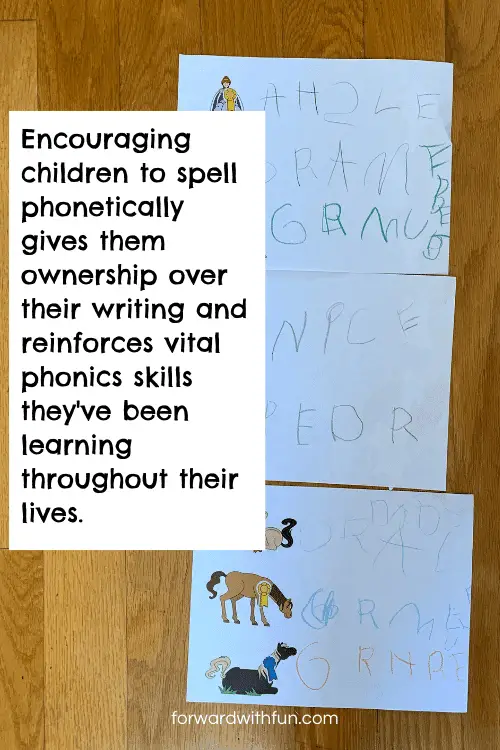
Children often ask how to spell words they want to write.
Instead of telling them what letters to write, try asking the following questions:
By encouraging children to listen for the sounds in the words, we as teachers, are building their phonemic awareness- a major reading and writing set of skills, kids will need to succeed in school.
When they ask you if their spelling is right, you can say yes. Remember, adult spelling is different from kid/kindergarten spelling. Both can be right.
At the end of kindergarten, teachers expect children to be able to write short words with at least a beginning, middle, and ending sound, but longer words take time and practice to learn the adult spelling.
Here is a letter for you to pass out to parents. You may notice, I wrote the letter using phonetic spelling.
Challenge yourself or if you're a teacher, the parents in your class, to read this letter. The letter explains what phonetic spelling is and why it’s such a developmentally important step in becoming a reader and writer.
Click the picture to download your own copy or pin it, to save for later!
Do you encourage phonetic spelling with your students?
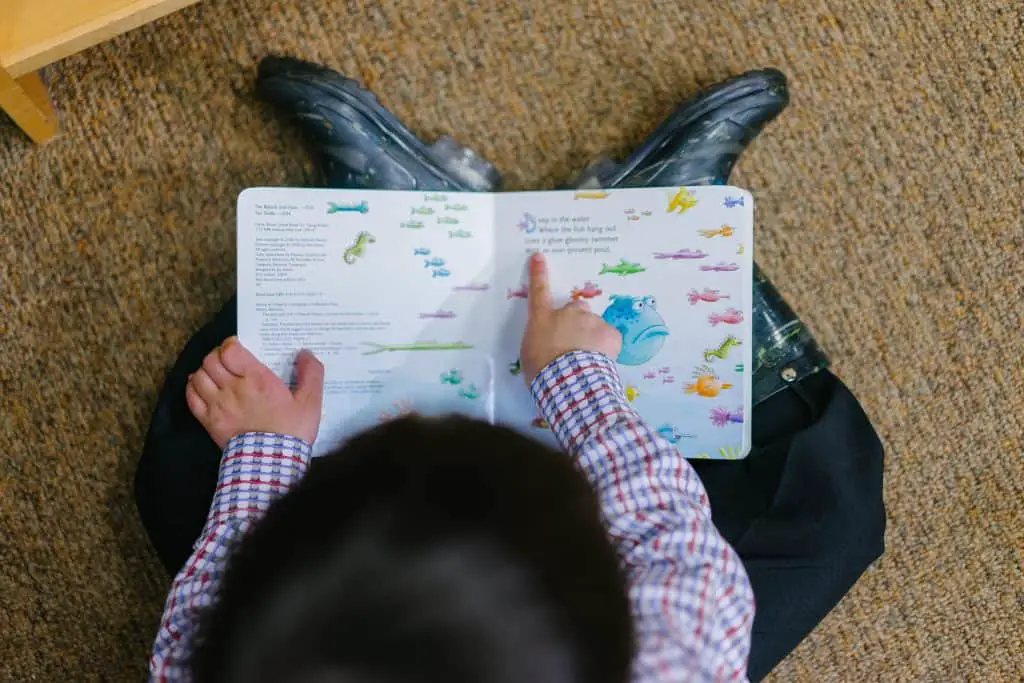
For kindergarteners, books offer excellent opportunities for learning about the world. Besides nourishing their imaginations, books help kids develop critical thinking skills, expand their vocabulary, and expose them to other cultures and practices.
Above anything else, reading aloud to your children is the number one thing we teachers recommend for kids ages 0-5. Children get many opportunities to see letters and words in action as they listen to a story, benefiting them greatly when it comes to learning phonics!
Literacy expert Carol Anne St. George wants children to develop a love for reading as early as possible. This suggestion is especially applicable for kindergarten students, the majority of whom are still in the early stages of their reading journey.
Parents and teachers play an essential role in choosing good books for children picking up this skill. They should provide children with impactful and strategic learning materials because these early stages, particularly ages 4 through 5, are crucial in cementing a love for reading.
Here are three characteristics you should look out for in books for kindergarteners:
A good children’s book uses simple but interactive language. Because kindergarteners are still developing more complex vocabularies and sentence structures, it is necessary that the books they read convey their messages in straightforward and easy-to-understand terms. Nonetheless, compelling storytellers utilize techniques such as rhymes and rhythms to keep their narratives engaging. A good book also tries to evoke a wide array of emotions and sparks the reader's curiosity through certain words and phrases.
One notable example of this characteristic is Our Little Kitchen which uses descriptive words such as chopping, slicing, whisking, and whipping. These words are not just simple, but they also evoke imaginative thinking. The book's simple yet fascinating plot effectively harnesses words that children can incorporate into their growing vocabulary.
One of the most critical elements of a children’s book is pacing. A good book for kindergarteners is neither too fast nor too slow as these children are still developing language, vocabulary, and independence. This type of balanced pacing is evident in Everything for Early Learning with its focus on foundational skills. As a workbook designed to approach mathematics and language arts creatively, it makes use of short yet increasingly complex activities. This effective strategy keeps children engaged as they turn the pages encountering wins as they progress through the workbook.
A balanced and easy-to-follow pace will keep the young readers busy and help them lengthen and strengthen their attention span. A gradual increase in difficulty level can also prepare them for longer books and independent reading as they progress in their learning journey.
Early readers tend to be visual learners, hence the popularity of colorful picture books. These reading materials provide children with visual stimulation and keep their eyes absorbed. Indeed, illustrated stories guide kindergarteners and maintain their interest as they go along the narratives.
However, illustrations aren’t the only ways children’s books utilize visual design. Another example is typography; book writers and designers often use font styles and sizes to convey a particular meaning or highlight a specific section. My blog post on Concepts of Print explained how print awareness works and how parents and educators can easily teach children this skill.
Typography can help in this aspect by directing the child’s eyes towards the different parts of a book. Clifford The Big Red Dog effectively uses typography in this manner. As a recognizable classic, the series uses repetitive visual elements in its books, making it easier for children to develop print awareness as a reading skill.
Children can benefit greatly from reading books that exhibit these three characteristics. These reading materials can impart significant value to kindergarteners and develop their love of reading and learning teach for the many educational years to come.
Have you found any great books for kindergarteners we should check out?
Concepts of print, sometimes called print awareness, is a person's understanding of how writing works. Without understanding these very basic concepts, one would not be able to read.
Imagine a child walking into a classroom who has never seen a book before. They might have no idea how to hold a book, where to start reading, or even that the jumble of confusing scribbles on the inside (yes, words) have meaning.
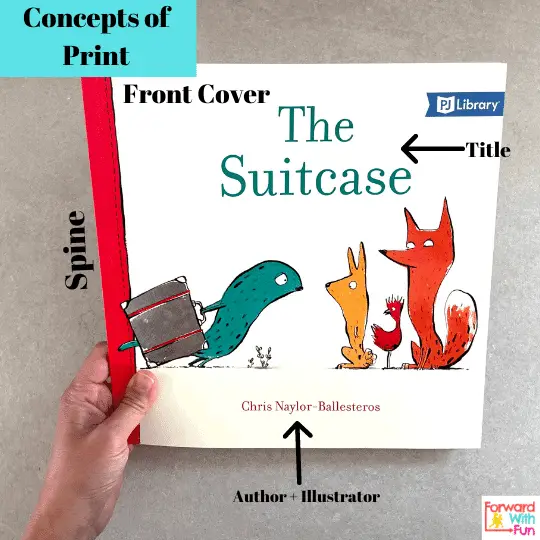
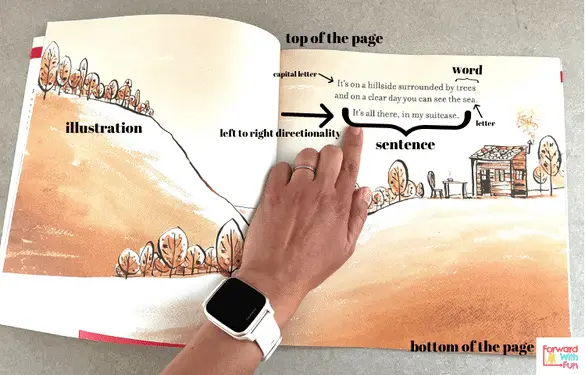
Reading, reading, and more reading! The more you read, the more exposure your child has to the concepts of print.
If you're already reading aloud to your child, they have probably picked up a lot of concepts of print by now.
Reading doesn't just happen when we open a book.
As adults we are reading constantly and automatically, everywhere we go: in the car, on our phones, reading mail, writing a note, food labels, advertisements, billboards etc.
There are many wonderful ways of noticing environmental print with your child such as:
In my read aloud remastered checklist, I help you maximize that bedtime story. You're already reading it...why not make it even more valuable by asking the right questions?
Download the READ ALOUD CHECKLIST and pick one category of questions to focus on each night to skyrocket reading comprehension.
One mom said, "I know reading is important, but I didn't really know which questions to ask. What are kids even supposed to know?"
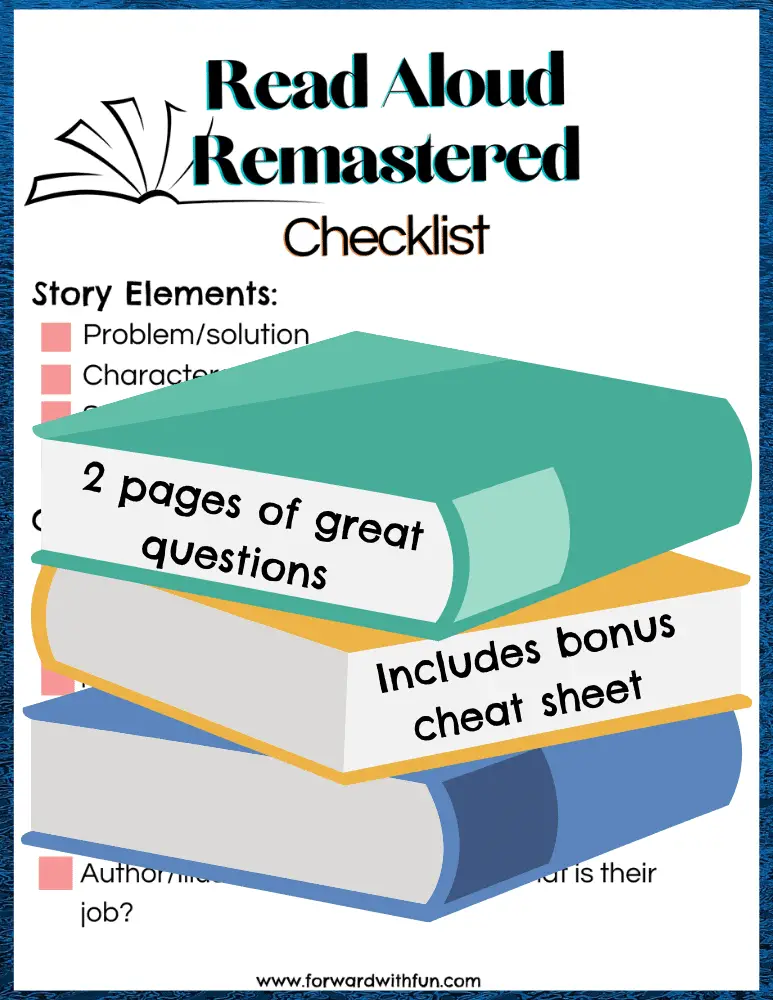
The checklist focuses on all the questions you should be asking your 4-6 year old during reading and includes concepts of print! So don't wait to grab it. Right now, I'm including a bonus cheat sheet at the end of the 2 pages of questions.
Once your child has mastered a set of questions, check them right off and focus on something else! I LOVE CHECKLISTS.
Welcome to the all-inclusive list of social emotional activities for preschoolers. These twenty super helpful activities help young children develop their sense of self as well as interpersonal skills.
Social emotional learning is nonacademic learning that focuses on a person's understanding of themselves and their feelings as well as their relationships with other people.
Studies have shown that kids who have strong social emotional skills in kindergarten have better lifelong outcomes in education, employment, and mental health.
Besides better outcomes in later life, teaching social emotional skills to 3 and 4 year old's is much easier due to the higher adult to children ratios in preschool. And teaching them skills like kindness, mindfulness, and understanding feelings will help them get their needs met and grow positive relationships with others in school and other settings!
*As an amazon associate I may get a small commission from any purchases you make using links in this post. Thanks!
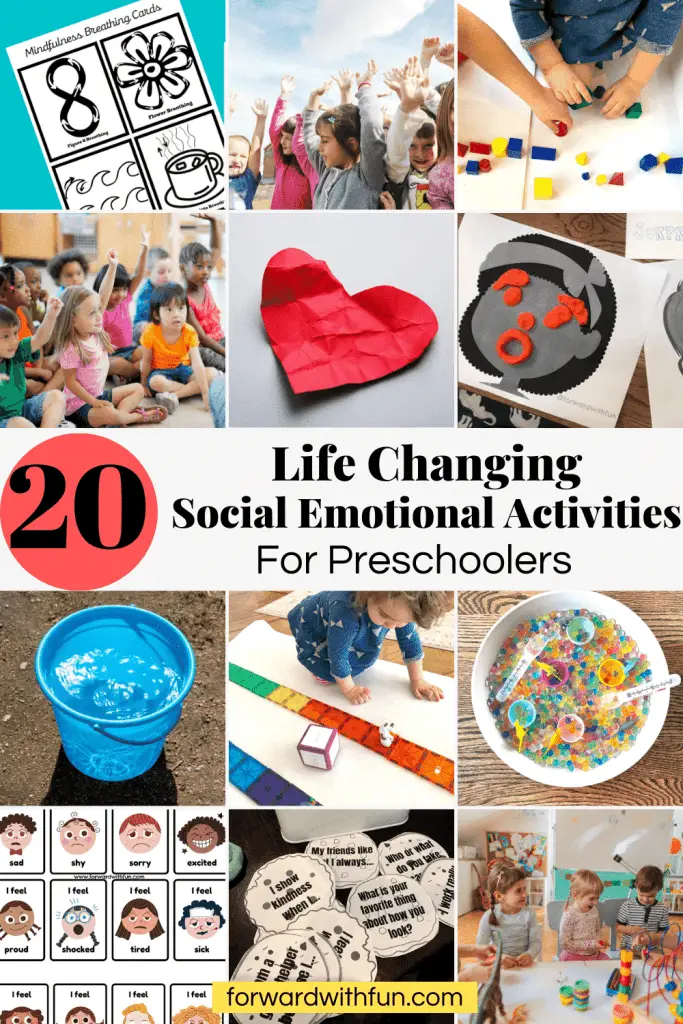
To help make sense of this all-inclusive list, I'm separating these activities into ones that develop sense of self and ones that develop interpersonal skills.
The sense of self activities help develop preschoolers' abilities to
The interpersonal skill building activities will focus on kids' abilities to
Studies from Yale have found that Kids who understand their own feelings in turn build stronger relationships with others. By teaching kids to recognize, label, and understand feelings kids can better express their needs without frustration.
Click the picture to grab your free playdough mats and begin learning about feelings right now!
Think Pixar's Inside Out but with more feelings. Build kids' vocabulary of emotion words by writing a bunch and putting them into a hat. Have children take turns picking a feeling word, have an adult read it to them, and then act it out for the other people to guess! Click the picture to snag these cards for free!
Sometimes it is difficult for preschoolers to figure out how to deal with their emotions, but it becomes easier when their situation relates to a story they know.
Some of my favorite feelings books that build self understanding are:

The last one in that list is called a social story, where children read about a scenario that is relatable to them and find out how the character deals with it. Social stories are helpful social emotional teaching tools that help make the big abstract ideas of emotions a lot more understandable for young children.
Kids who practice mindfulness breathing have a great tool in their toolbox when they feel overwhelmed or frustrated. Mindfulness is all about being aware of yourself in your environment.
These fun breathing cards make deep breaths fun by turning them into hot cocoa or flowers! Print them out and laminate them to pull out for your kids or students to use during the day. Don't forget to follow the arrows with your fingers as you breathe in and out. Visit the shop to purchase.
Mindfulness is all about being present and really feeling the world around you without distraction. One of the best ways to do this is to use our 5 senses. Have your child lie down and then ask them to name:
Try this grounding technique to help center yourself and your child. It's a great way to help busy minds rest or get ready for bed.
I created confidence cookies as part of The Fun Club, where kids aged 4-5 get sent 5 weekly activities that teach them reading, math, and social skills.
Kids and adults practice positive self talk, building their confidence and self-esteem.
Each day during dinner, I play "Rose and Thorn" with my kids. This is a time to reflect upon our day where we share our favorite and least favorite part of the day.
During this time, kids are able to share about their day in a way that normalizes the "bad" and the "good." Not everything is always going to be positive, and by creating this time together, children know they'll always have a designated time to sort through the important things going on in their lives.
My daughter has had this up in her room for 2 years and whenever she gets upset, she goes to look at her calm map for something that brings her comfort. Having a calm map has been immeasurably helpful.
Since my daughter came up with the list for each category, she has a long list of items that she has self declared to help her feel calm. Such a relief to me! Click the photo to download yours for FREE!
The trend on Instagram lately has been sensory play, and you know why? Because it is soothing, calming, and helps preschoolers regulate their needs better. In fact, sensory bins are the perfect social emotional activity for preschoolers. They can be a go-to as a calm down activity when you need one!

If you're looking for some inspiration, check out this post on 50+ sensory bin fillers to use with preschoolers.
Interpersonal skills are also known as social skills and help develop relationships with others.
This one might be a no brainer, but did you know playing board games with preschoolers is a great way to build social skills. Here are the skills playing board games build:
My favorite board game to play with my preschooler is Candyland, but you can also quickly make your own like THIS!
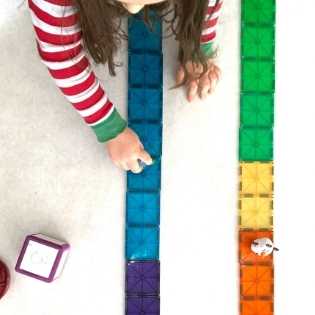
Preschoolers love building, so bust out whatever blocks or building items you have for this social emotional activity that takes no time to prep and builds teamwork, turn taking, and cooperation.
Pair off children in teams of 2 or more and challenge them to work together to build a tower that is X blocks high. Watch them work together, take turns, and feel the pride and success of reaching their goals!
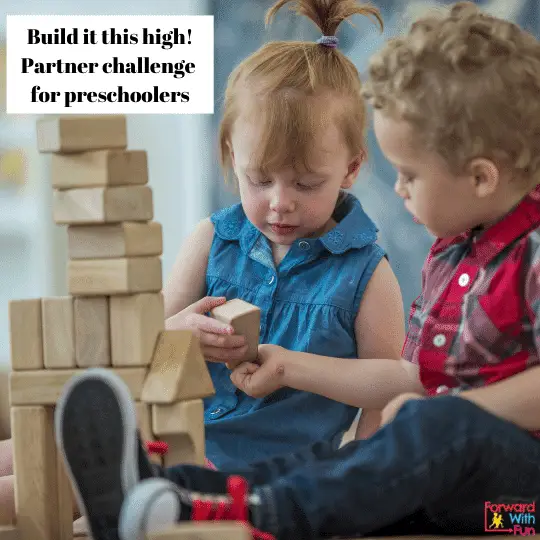
Let's practice one of the hardest preschool skills...sharing! All you'll need is a 10 of one kind of item. It could be marshmallows, blocks, squishy toys, anything. Talk about why sharing is important: it's fair, makes people feel good, it's kind.
Practice dividing up the small number of items, by repeating "one for you, one for me, one for you, one for me" and placing one item at a time in front of each person. If there is an odd number, problem solve. What can we do? Should we cut it in half? Should we place it back in the box? Preschoolers can come up with some really creative solutions and take pride in being "fair."
Hooray for a gross-motor social emotional activity! If you've got wiggly preschoolers, this one is going to be a hit. Have everyone stand in a circle or on a specific spot on the rug, if you're in a classroom. If you're at home, make a few designated "spots" for everyone playing.
Have one person be the leader for the first round and have that person call out, "Switch if you like _________," or "Switch if you have _______." Model this for the kids, and then they can take turns being the leader.
When kids learn about their similarities, they learn that we all have more in common than we do different. Kids will often build a friendship over something the other child has in common with them, so this can be a great jumping board. "Hey you also love PJ Masks!?"

Preschoolers often really connect with music! I love to start the day with a Hello Song, where kids go around greeting one another practicing their chosen way to say "Hello!"
Some suggestions I give to students are to try saying hello in multiple ways: a wave, high five, handshake, saying hello to the kids in the room.
Some of my favorite hello songs are "Hello, How Are You?" by Dr. Jean Feldman and "Hello Song" by The Kiboomers.
There are SO many Hello songs out there, if you just search that phrase!
Sometimes, kids need a little nudge to talk to new people in their class. That's where "Find your partner" comes in. For this game, give kids a specific colored item and have them find someone with that same color then freeze, raising their item up in the air.
I've seen this game done with Magna-tiles, where kids first look for someone with the same color and then someone with the same shape. The game is complete when everyone finds their partner, so make sure you have a partner for each kid!
Brainstorm ideas of kindnesses. We came up with saying thank you, sharing with a sibling, and cleaning up a big mess.
Compare those 3 kind actions to the small, medium, and large objects.
Name the kindness that goes with the object and then let your child drop the kindness item into the bowl with water.
Observe what happens- the ripples and movement in the water is like kindness moving out into the world and touching the lives of others who are more likely to make kind choices. We will call these kindness ripples.
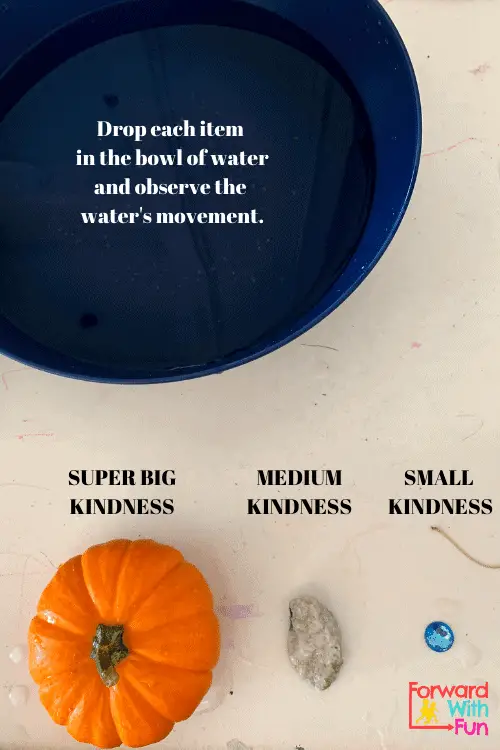
So this activity might be my favorite, because I wrote my Masters Degree thesis on it! In my classroom from 2010-2011 I did research on compliment giving as a way to build confidence in children but also as a way to build friendships between children.
Here's what you do:
Go around in a circle taking turns saying something nice about others in the circle. At first preschoolers might give compliments like "I like her," or "I like his pants."
Over time, their compliments often evolve to be more based on actions and feelings like "I like to play with James because she is good at sharing," or "Tamra is very good at writing her name." It is important for the adult to model compliment giving as well.
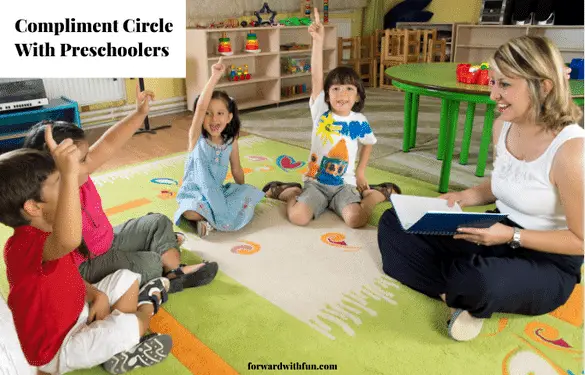
Make a kindness calendar for the week with random acts of kindness for Monday-Sunday. Each day read the act of kindness for that day and try to complete it by nighttime. The next day, discuss, how did that feel for you? For the other person?

I read this to my own children and students every single year. I cannot recommend this book enough, because it helps children very concretely understand how their words effect others in both positive and negative ways. The language used in this story is something that we come back to over and over again with my now 3 and 6 year old.

"That hurt my feelings!" What a very abstract concept for young children. In this activity, children can see how their words can wrinkle a heart and how even when we apologize, hurtful words can stick.
Cut out a heart shape from a piece of paper. Take turns saying "mean things" to the heart. Each time something mean is said, make a crease or fold onto the heart until it's covered with folds and creases. Then try to smooth out the heart to be back to what it was before.
Can it be done? Even when we say sorry for harsh things said, they can still hurt out hearts, so be careful with your words!
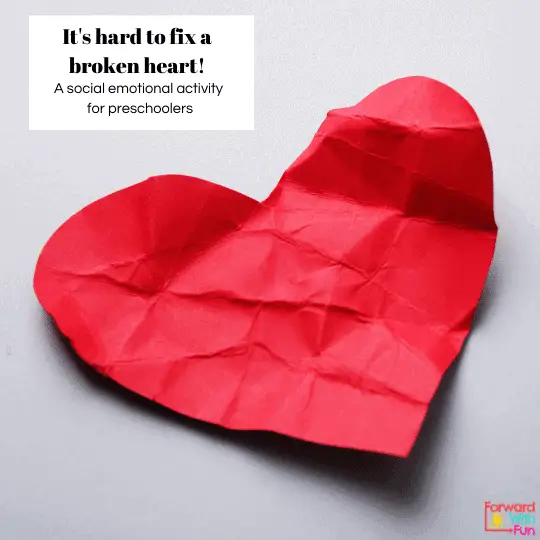
If you're looking to switch up your sensory bin, check out the 50+ list of sensory bin fillers and how to use them.
Sensory play provides so many benefits to young children, and most of all it's fun so kids can play to their hearts content while you can sit back and relax. As you change out sensory bin fillers, it shifts the kind of play kids create, sparking creativity and learning. So read on to grab your handy list, print it, and put it on your fridge for a quick sensory bin activity anytime!
*As an Amazon Affiliate, I may make a small commission based on your purchase at no extra cost to you. Thank you.
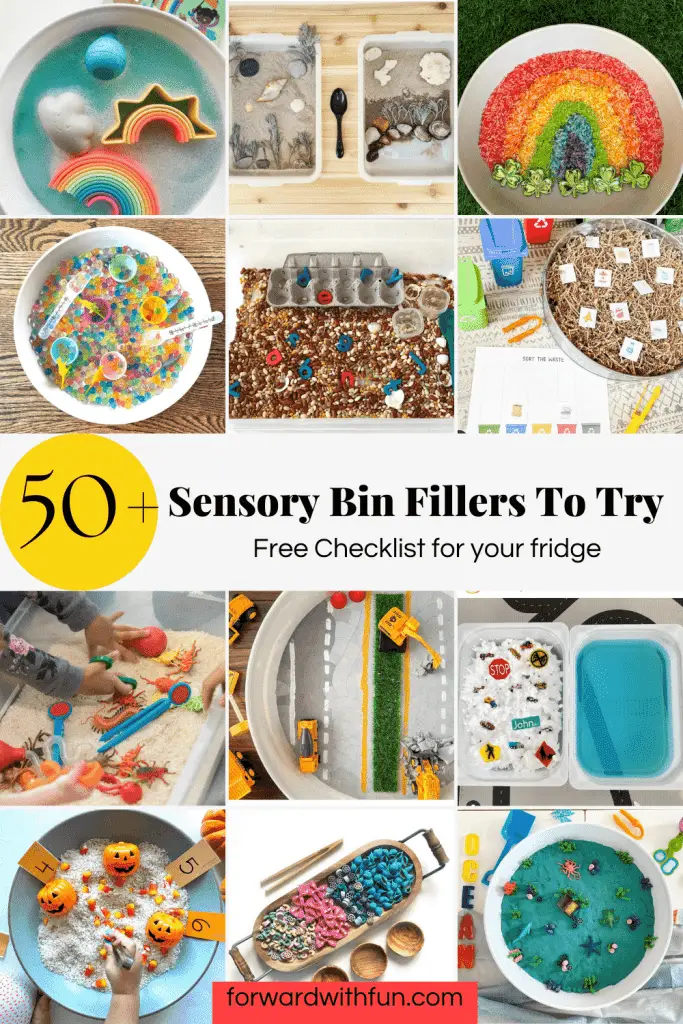
Sensory play is any kind of exploration kids can do with using their senses: hear, smell, taste, sight, and touch. But it is often used to describe exploratory play children can do with their hands while still stimulating some of the other senses.
Often kids will describe that sensory play just feels good! That is due to their curious nature and sensory needs being met by these types of activities!
Sensory bins are one type of sensory play. There are so many types likes sensory trays, sensory jars, sensory kits, and more. Even experiences like being in a giant ball pit are considered sensory play.
Benefits of sensory play include:
As children scoop, pour, and maneuver the sensory bin fillers along with whatever else is in the bin, they're improving their muscle strength in their wrist and fingers. These small muscles are vital for fine motor skills development such as buttoning, tying, and writing.
Naming the fillers as well as the items in the bin provides important vocabulary opportunities. As children explore the sensory bin they are using language and promoting speech development.
And if you're adding in elements like numbers and letters, kids will play to learn with their sensory bins. Think of all the opportunities for counting, measuring, and labeling things as their little hands go to work.
A sensory bin is any type of container that you fill with a sensory bin filler and then other objects for children to manipulate. This can be as small as a bowl or a tray or as large as you want.
My favorite sensory bin is a clear container from Target. I make sure to purchase it with a top so that if we're doing messing play, I can close it and put it up high for another day. Often I am lugging play from home to school to be shared by all, so having a top helps with that too.
All you have to do is grab your container, print out the list of more than 50 sensory bin fillers, pick the one you want and throw it in. Then, add whatever else you want like:
I've divided this mega-list of sensory bin fillers into taste-safe and non-taste safe. Taste safe means that if kids lick or taste the filler that it wouldn't be dangerous; however it doesn't mean that the filler is not a choking hazard! So please, as always, supervise your child when doing sensory play.
Don't forget to download your 50+ sensory bin fillers checklist at the bottom of this post. Keep it on your fridge for fresh sensory play ideas!
Dyed rice is very popular, likely due to it's satisfying texture and easiness to make. I thought it would be tricky to dye my own rice, but surprisingly it was incredibly easy. Here is the 2 step recipe to make your own rice sensory bin filler!
I used red, pinto, and white beans (plus a little bit of corn) to make this sensory soup learning bin. There are many ways to incorporate learning into sensory play and this is just one example!
Have you heard of water beads? Originally used for floral decorations, water beads come to you as teensy little balls. When you add water to them, they grow into satisfyingly squishy little spheres. In this quick little sensory bin, I used water beads as the sensory base, reused medicine spoons, and threw in some Easter Egg halves plus baby dinosaurs!

Shaving cream is a cheap and easy to use sensory bin filler, and I just love how @daily_dig created this car wash for her little one in a double sensory bin that screams fun! She used little vehicles and stop signs, items of interest for her kiddo to make it something he can't resist!
Pairing loved items with new textures can be a great way to introduce new tactile sensations to children who may have sensory sensitivities.
You know those paper shreds that come in packaging? Save them for a really great, reusable sensory bin filler. That's what @farmhouse_mama_blog is teaching her kiddos in this earth friendly sensory bin featuring a printable by Comet Printables. Sensory bins pair so well with learning activities!
Bring nature into your home with play sand and found objects. I love this low cost, low prep sensory bin by @our.play.inspired.journey. For city slickers like us, this is a great way to get some nature into our play. And hey, you don't actually need to buy anything to make sensory play happen!
If you're worried about little pieces, your new sensory bin filler might just be bubble foam! It's sure to be a hit, especially with babies. You can use regular soap, but sometimes I put a little dish soap + water + food coloring in a blender and it makes it extra foamy!
Check out this adorable, baby friendly weather themed sensory bin by @threetimestheplay.
Pasts can be dyed with food coloring or painted as this mama @sensory.play.at.home shows us. Pasta is so versatile as a sensory bin filler because each kind has its own texture, shape, and gosh, they're so fun to look at!
If you haven't played with kinetic sand, you have to try it! It stays together preventing a lot of mess and has a texture that really delights both adults and children. This ocean themed sensory bin by @daily_dig uses kinetic sand as a sensory base-it's so easy to shape! I spy some adorable dyed pasta too!
@Chloe_duffy3 takes oobleck to the next level by painting it to create a concrete looking street for the diggers to excavate! Wow! Have you ever made oobleck? It's 1 cup water and 1.5 cups cornstarch. It is a non-Newtonian fluid and behaves like a solid and a liquid! It might look solid in this picture but when picked up, it drips and oozes! Totally awesome.
Have some extra noodles in your fridge about to go bad? I know just what to do with them, thanks to @mammassori123. She dyed spaghetti with food coloring and tossed those bad boys in the plastic tub with some plastic bugs. Viola, an easy to make a baby friendly sensory bin! Add scissors for older kids to practice cutting!
That blue water is actually vinegar. When you add baking soda, a super low cost grocery item, to it, it'll fizz up. Let the joy begin! You can use either baking soda or vinegar as the base in order to create this delightful chemical reaction that's super safe!
Those adorable penguins have been frozen by @momthemage in little ice cubes using a muffin pan, so they can glide around the tray. Oh and did you see how she snuck in some learning with the numbers? Can you count 3 ice cubes? 5 ice cubes?
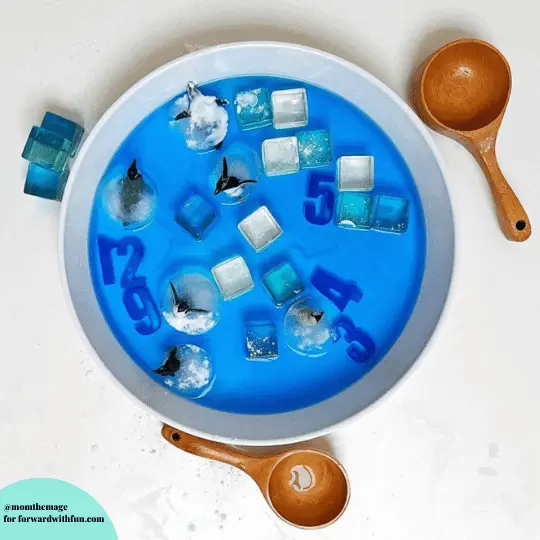
Teach your preschooler their letters in 4 unique ways with this giant packet of alphabet playdough mats! No email subscription required. Just print and play!
*As an Amazon Associate I may get a small commission if you decide to purchase from my links. Thank you.
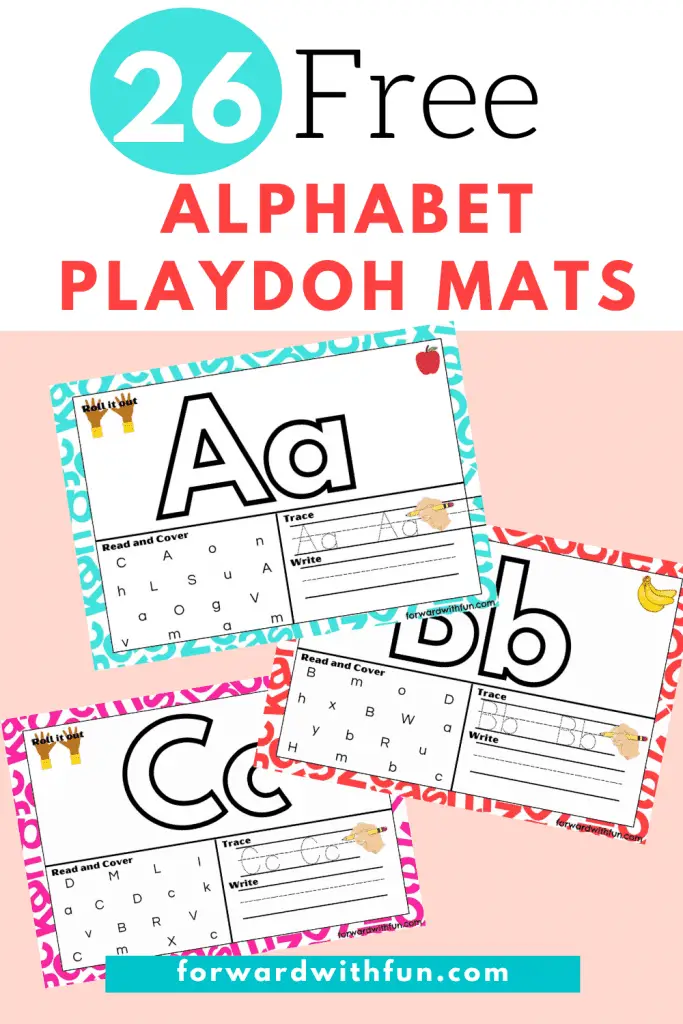
The MAJOR difference is that they promote letter learning in 4 different modalities catering to many learning styles:
By playing to learn with these alphabet mats kids are exposed to letters through art, reading, and writing.
The more exposure a child has with letters the more likely they are to remember the letter. But we aren't just going to practice letter recognition; we are also building their ability to independently write each letter!
Also (updated version!), there is a little picture of a word that begins with that letter in the top right hand corner. So there is a phonics element to each mat as well!
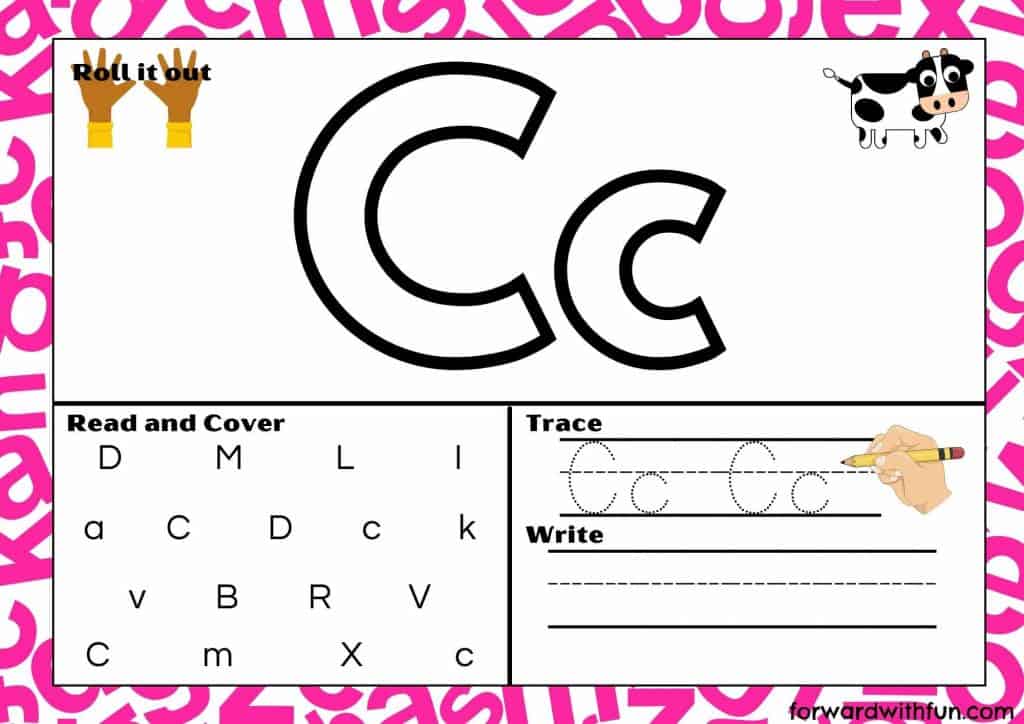
Side note: it drives me crazy to see uncommon sounds for each letter like giraffe for G when we teach that G says /g/ as in golf. All the pictures on these printable alphabet mats match the most common phonetic sound for each letter!

The benefits are HUGE and three fold.
Using playdough:
As children learn to write, they don't just need to memorize the strokes it takes to form letters. There is so much more.
Writing requires:
With the alphabet playdough mats, kids will roll and shape playdough as well as make it into small balls to smush onto the correct letter in the "Read and Cover" section.
This very intentional kind of play strengthens hands, finger, and wrist muscles required to write properly!
These beautiful letter learning mats are super easy to use!
When writing on the mats, you can use any dry erase markers. Provide your preschooler or kindergartner with a tissue or small cloth to erase once they are done.
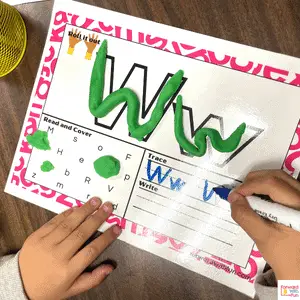
I find that laminating the alphabet playdough mats works makes them last longer, and I found a very affordable and effective laminator on Amazon (stays between $25-$30). I've used it for 3 years and it's still works perfectly. I'll also link the laminating sheets and dry erase markers I love best.
A KinderReady Summer is your one stop shop for fun activities that target the exact skills kids need as they enter kindergarten.
Each week for 8 weeks, you'll get 5 simple pre-planned activities sent to your inbox. All you have to do is read the instructions.
The focus of A KinderReady Summer is to target the very important skills that come just before reading, writing, and doing arithmetic.
-letter identification, capital and lowercase
-letter sounds
-beginning sounds
-shape names and attributes
-number identification to 10
-counting with one to one correspondence
-pattern completion and creation
-name writing
-fine motor development
I bust out the kids' favorite independent reading activities for a minimum stress, maximum fun phonics time. These can be used one on one, as kindergarten reading station activities, or be done with a whole classroom of kids.
All 3 of these independent reading activities have many ways to differentiate to meet the needs of all your young learners and build their phonics skills. So whether you're working on beginning and ending sounds, letters, CVC word reading, or digraphs like "sh" and "ch," I've got something for you.
Without further ado, the 3 most begged for independent reading activities are...
*As an Amazon Associate I may get a small commission if you decide to purchase from my links. Thank you.
Get ready to sit back and watch kids get excited to practice reading all on their own. You might even have time to sit down and drink coffee while it's still hot. The best part? It's all hands-on!
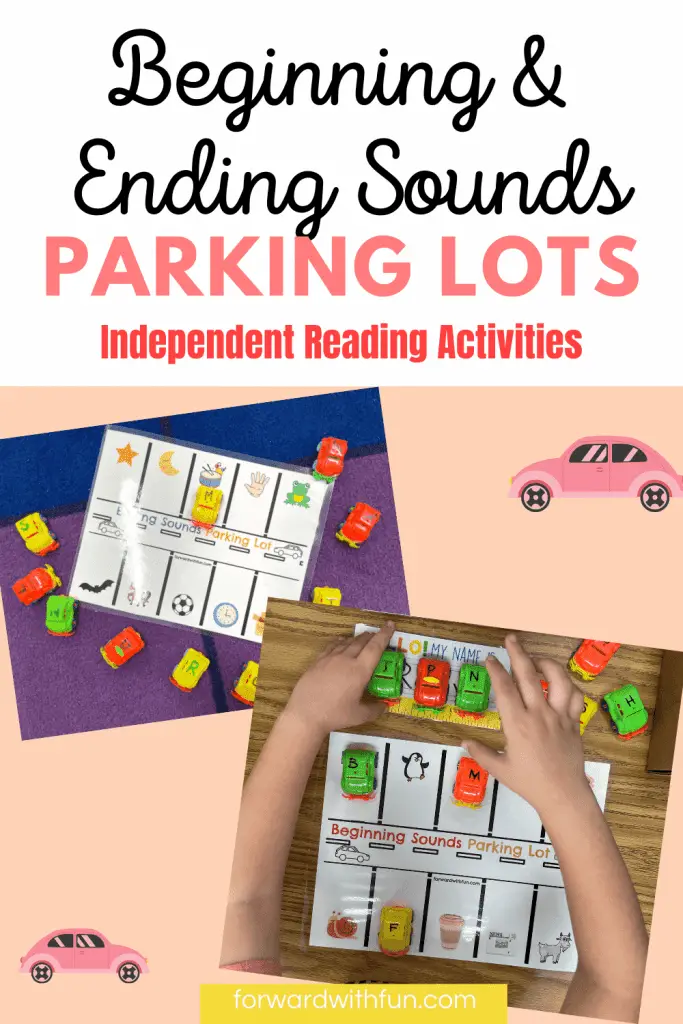
Kids dream of the day they'll get to drive, so bring that dream to life with phonics parking lots. It's so simple, you'll need 10 plastic cars, hot wheels, or trains you have lying around the house.
If you don't have ten little cars you can usually pick them up from the dollar store or here on Amazon.
Print out the 3 beginning sound parking lots or the 3 ending sounds parking lots and you're almost ready to play. Just label the cars with the 10 necessary letters using a dry erase or sharpie.
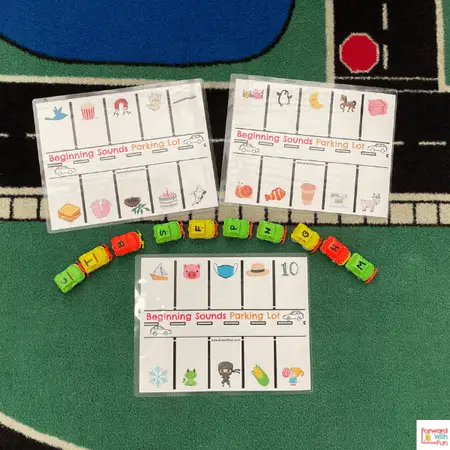
All the beginning sound parking lots use the same letters, and the ending sounds have the same letters on each of their mats too! This makes it so you only would need to change the letters on the cars when you're ready to move from beginning to ending sounds.
I love this game because kids are SO psyched to play and can do so independently. So they're working on their phonemic isolation (isolating sounds in words), while I can step back and beam with pride.
Kids can play this independent reading activity with a partner or on their own. You don't need anything but a sharpie, crayon, and popsicle sticks.

I played this game with my kindergartners using CVC words, but you can also play it with the alphabet, shapes, numbers, sight words, spelling words, etc.
Prep this quick independent reading activity in 5 steps:
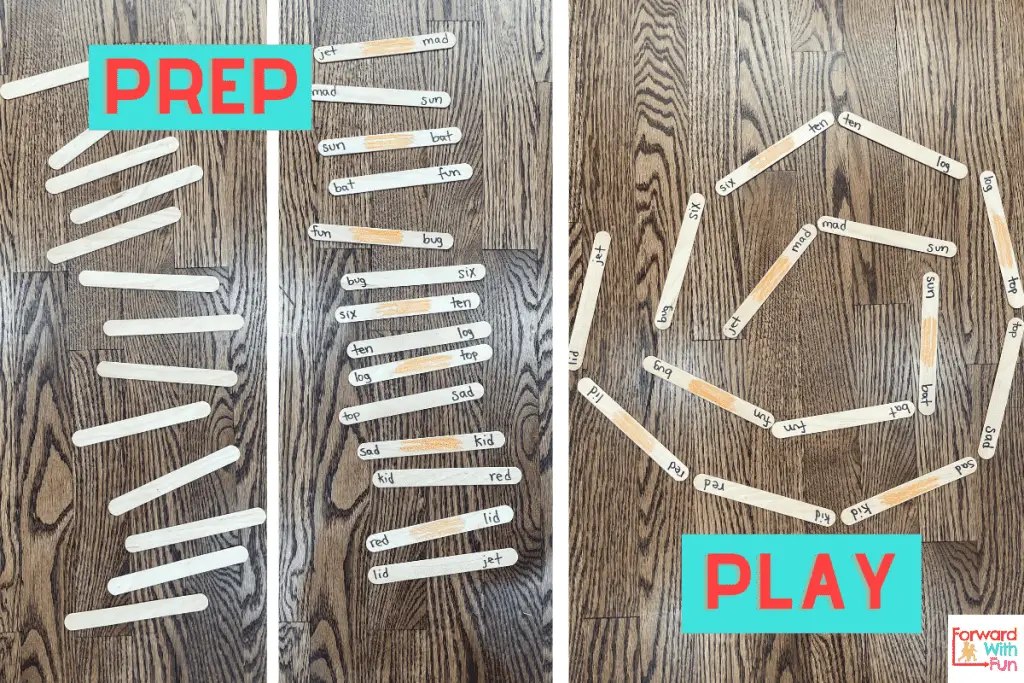
Once you teach this game to your kids or students, they'll know how to play forever. This makes it the easiest independent reading center. They see the popsicle sticks, and you barely have to say a word!
Just print and play. Kids freak out when you share they'll be reading and building based on the words they have on their cups.
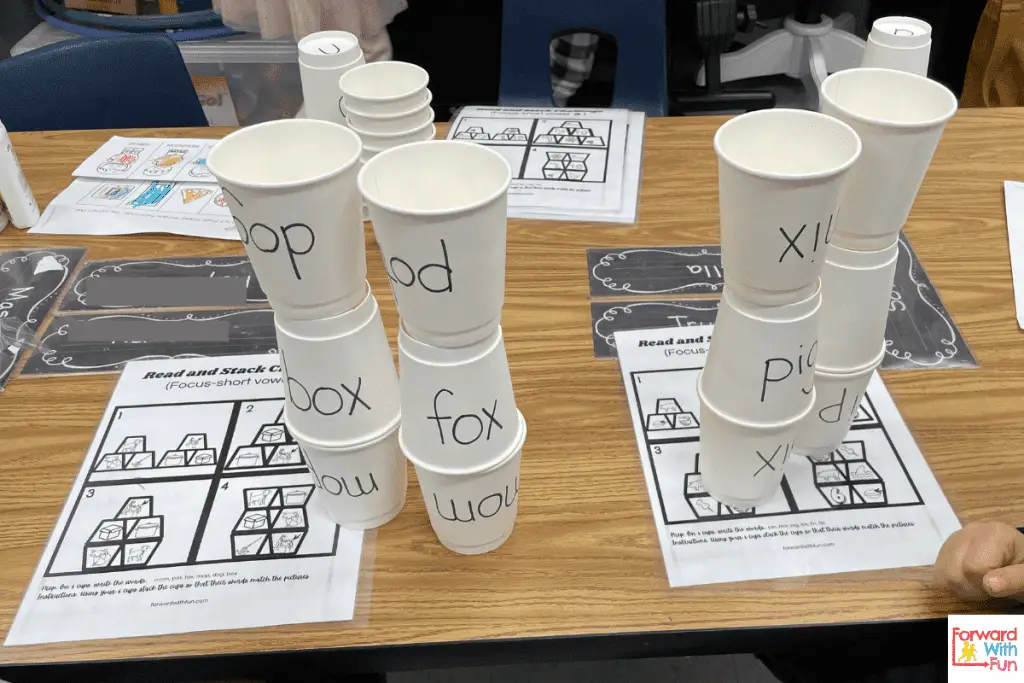
The Cup Stacking Challenge bundle comes with 4 building challenges per vowel and digraph. So you get stacking cards that focus on CVC words and digraphs ch and sh. The set comes with 7 sheets of challenges, focusing on each of the vowels in CVC words and the two digraphs.
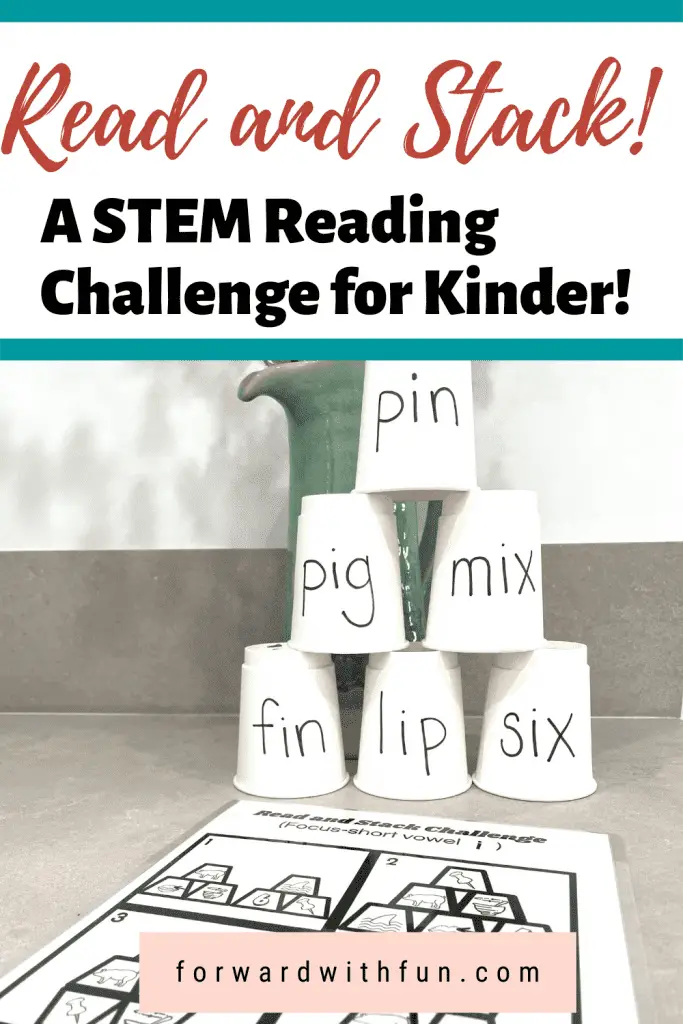
Each challenge requires only 6 cups. Use either plastic or paper to write the words listed at the bottom of that challenge's sheet. Below is an example with the "i" words using paper cups and the "sh" words using plastic cups.
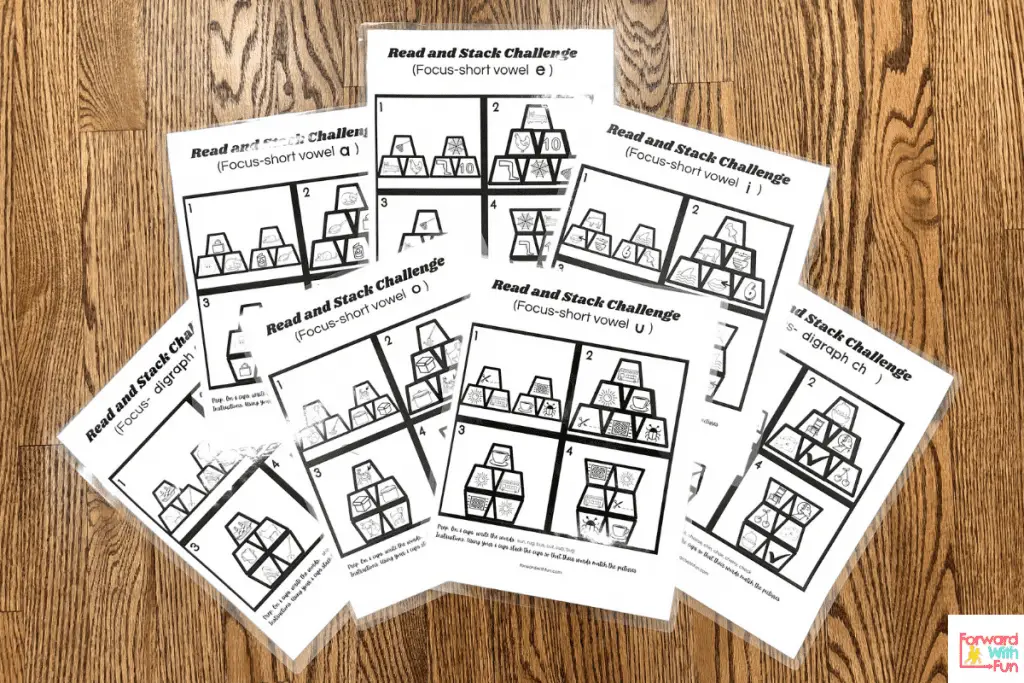
Download your bundle now to start playing these independent reading activities that kids beg for!
Most kids begin reading in kindergarten at the age of 5 or 6. What does "reading" look like at this age? Well, in kindergarten kids by sounding out simple 3 letter words using their knowledge of letters and sounds. They also read words they have explicitly memorized aka sight words.
Everyone learns at different paces, so don't be worried if your child is not yet doing this. However, if you want to progress their learning through fun, hands-on games such as the ones you just read about, check out our signature program, The Fun Club.
TRUTH: The Fun Club is a monthly subscription with 20+ activities a month that WILL TEACH YOUR CHILD TO READ (and so much more).
Each week includes reading and math activities that transform learning at home. Suddenly learning goes from being a chore to being the highlight of your day. Activities progress from beginning letters and numbers to mastering kindergarten reading and math standards.
Kids in The Fun Club can read this to you!
Whether you're looking to make learning fun or catch your kiddo up, join The Fun Club and start playing to learn.
When it comes to introducing ending sound activities, kids may feel a little out of their element. For so long, they've been taught phonics with a focus on beginning sounds. "B is for ball!" Now we start telling them that there is an "l" in ball, and they get all discombobulated.
Here are the tips, tricks, and best ending sound activities that I use to teach my own kids and my kindergarten students. These hands-on activities really make the sounds click and stick in their brains. Plus, the best part is...they're super fun and easy to prep.
*As an Amazon affiliate, I may get a small commission for purchases made through links in this post.
This might seems like a no brainer to us, but kids are not aware that there is a beginning, middle, and ending to each word. This concept of a word being a visual thing, rather than just something you say, can really confuse children.
When I set out to teach ending sounds, I always begin by showing my kindergartners the word as three parts. This is often known as using Elkonin boxes, a visual reading strategy to help kids understand the word as made up of separate sounds.
Using the Elkonin visual, I help children segment words into the phonemes, aka sounds, they're made from, and point to each box. By attaching a visual, many light bulbs suddenly go off.
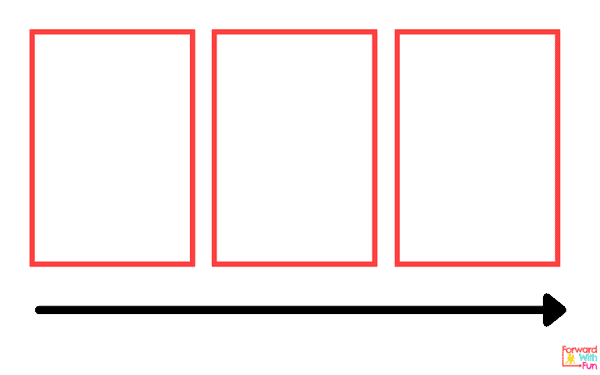
A second strategy for teaching ending sounds, is to speak like a whale, from "Finding Nemo." Elongate the word, and when you hit that last sound, make it super clear: GOOOAAATTTTTTTT. As I do this, I pretend I'm visually pulling a word, as if it were a piece of bubblegum, with the ending sound landing in the palm of my hand. Then I ask, "What sound was here, at the end?"
Stretching the word and asking the kindergartners for the sound (instead of the letter) allows them to work on hearing the ending sound without knowledge of letters yet. This strategy builds an umbrella of skills called phonemic awareness, the understanding that words are made up of sounds.
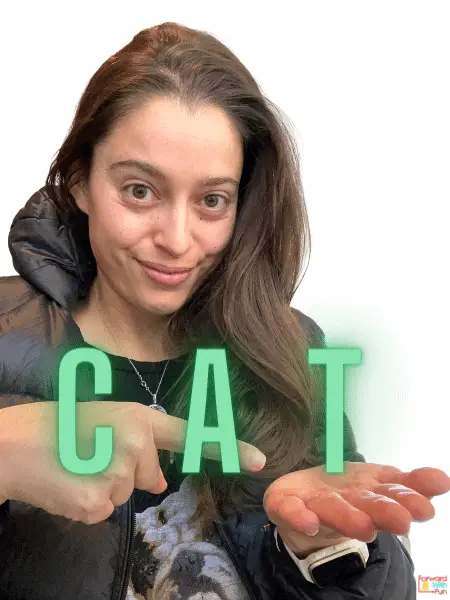
More than anything, I know kids learn best by having fun. So I try to bring the ending sound activities to life through games, imagination, and when possible, movement!
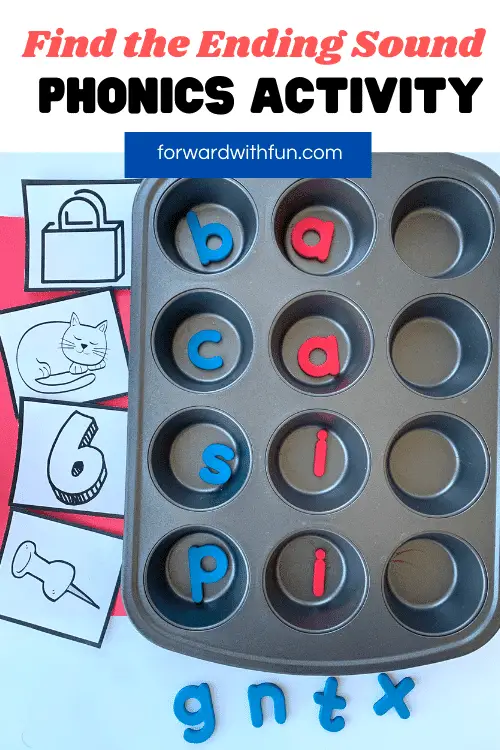
Remember those Elkonin boxes, I mentioned? They can be used to represent sounds or letters, and this muffin pan activity will help kids really visualize the ending sound of each word.
Turning your muffin pan sideways, you now have three perfect sections to help segment each word. This muffin pan game works best with CVC words (that means consonant, vowel, consonant) and you can even find the printable CVC picture cards right here.
These are the alphabet letters we love for teaching phonics. They're magnetic, and the vowels are red which especially helps for teaching middle sounds.

Set up your words, so that only the ending letters are missing. Saying the sounds of the beginning and middle sound, help your kindergartner listen for the missing final sound.
We have played this game for beginning and ending sounds, and it's got to be one of my all-time favorites. Kids always go gaga for this game.
The Toy Thief has stolen some items from around the house that need to be rescued. Now, to teach ending sounds with this game, you must be rather intentional with the objects you choose. For example, an elephant toy, has an obvious ending sound: t. But do you know the ending sound of horse? It's not "e." It's "s."
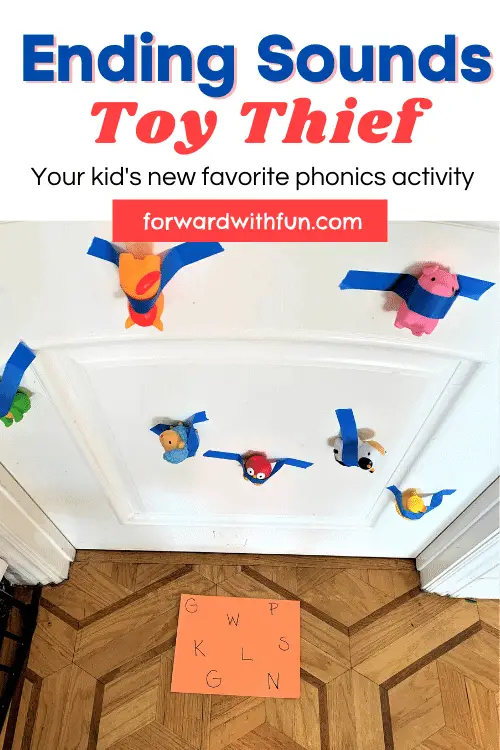
Write the phonetic ending sounds of each word on a piece of paper, and hide the toys. We used blue tape to hang them on our door, but you can also trap them under a laundry basket or hide them in different drawers. Be creative!
Have the kindergartener in your life rescue the toy and match them to their correct ending sound. Remember, it's about hearing the sound at the end of the word, not necessarily the letter. Tarantula would NOT be an "a," it would be the "uh" sound which goes with "u." Grown ups, I know you can do this! Haha!

This game requires barely 3 minutes of prep and also strengthens kids' hand muscles while they play. So let's build those fine motor skills and learn about ending sounds at the same time!
Choose a basket or a pan, and get out some blue tape. Make some overlapping lines over the top of the container so that there are multiple individual sections. In each small section, place a letter that is a common ending sound. I recommend using: g, n, m, p, d, s, r, l, k.
Give your kindergarteners salad tongs or these kid friendly pincers and have them rescue the letter that ends each word you call out: bag, soon, mom, hop, bed, gas, star, bell, sock, etc.
If you're playing this in small groups in a classroom, it would be great fun for the kids to create their own blue tape webs to reduce the prep for you.
This one is quick but effective. Place 3 Post-its notes on a table in front of each kiddo. Have the children clearly print the letters "D," "N," and "K" on them. I like to use 3 very different sounding letters to make it the easiest to discern.
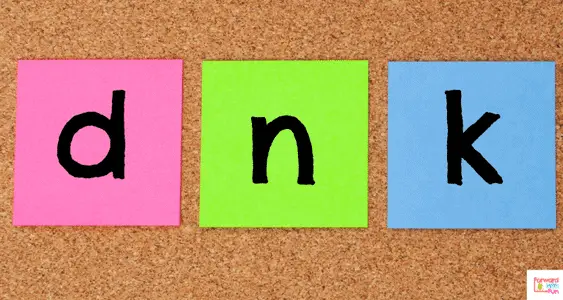
Call out words that end with only those sounds and have the kids SMACK the matching ending sound in front of them.
Want to use those letters for the activity? Perfect. Just call out these words:
Can, Kick, Sad, Bed, Soon, Fine, Pack, Ten, Kid, Sick, Quack, Pen, Red, Fun, Lick, Kitten, Jade, Stick, Bird, Salad.
Invite your child to toss a bean bag at a group of objects. Where does it land? Say the word, and stretch out the word. What sound did you hear at the end?
If you have got a kid that has a lot of energy, this is a great game that incorporates a physical aspect. Kids get excited for their turn to throw the bean bag, and you can't lose. Everything has an ending sound! It's simple but effective.

In this ending sounds activity, everyone wins. This set of BINGO boards all have the same pictures but in different spots. This way, kids aren't copying off one another but still get the joy of always finding a match.
You'll need either magnetic letters or write the following letters out on index cards: D, D, G, M, N, N, P, T, T
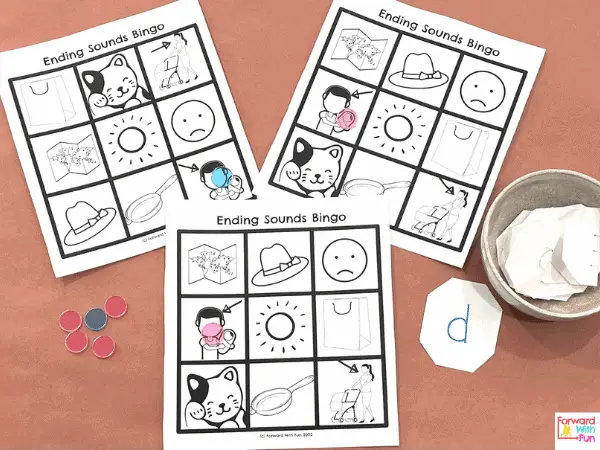
Each time the kids match the letter to the picture, they can use stickers or BINGO chips to cover up the picture.
The most fun way to set up the game is to put each of the ending sounds in an envelope or even in plastic Easter eggs. Have your kiddos choose a letter and find a word that ends with that sound.
Kids will often try to match with beginning sounds, when first learning about ending sounds. When this happens, I use the stretch the word strategy and "hold" the ending sound in my hand. Which sound did you hear at the end?
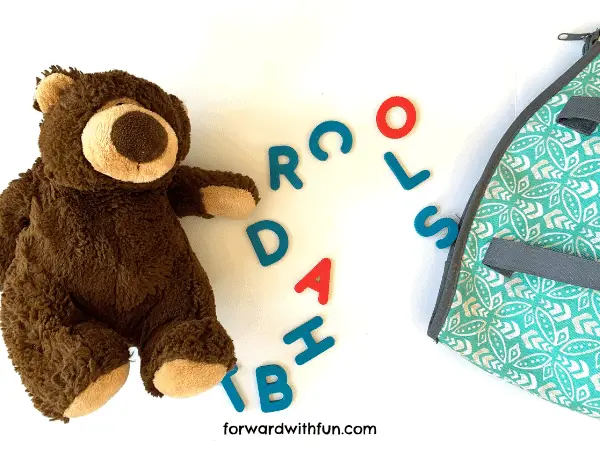
Now this activity is more challenging than the rest, due to the fact that kids will need to be more independent in isolating ending sounds. So I would do this one after you've tried all the rest of the ending sound activities.
In a bag, place the letters that are common ending sounds: D, M, N, R, T, S. There are more, but those will do! Have a stuffed animal host this challenge. Let the Letter Bear pick a letter out of a bag, and have kids go on a hunt for something in the room that ENDs with that letter. It's a challenge, but wow, doesn't it feel great when they get it?
Of all these ending sound activities, which was your favorite?
When my girlfriends and I sat down on New Years Day to make our vision boards together, I thought, "Gosh, why don't we ever make vision boards for kids?"
What I thought was a cute little craft ended up revealing a lot more about me than I expected. So the next day, my daughter and I made vision boards together.
We both ended up learning a lot about ourselves, finding hidden passions and setting goals based on what we learned.
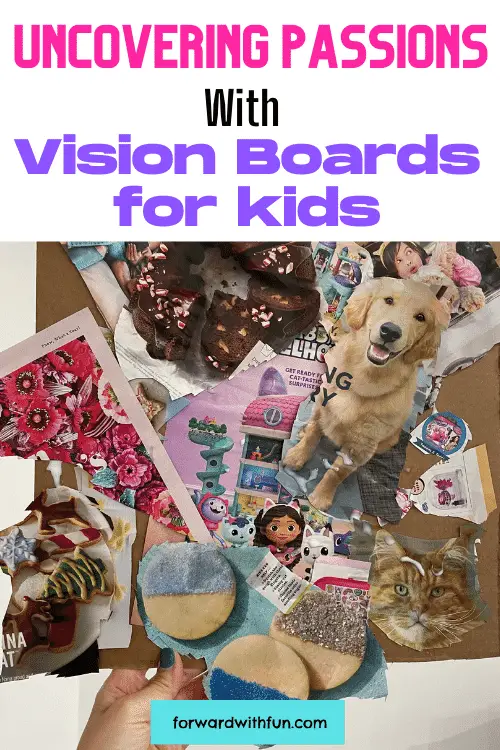
A vision board is a visual display that documents your hopes, interests, and goals for the future. The idea is that by displaying these goals and ideas visually, in a place where you'll see it each day, you'll do just a little more to work toward those goals.
If you're into the idea of manifestation, some people believe that just by putting those goals and hopes into the universe, you have a higher chance of making them your reality. Now, I'm not guaranteeing any magic, but I think that there is some merit in setting goals and keeping them top of the mind, especially for kids!
After I made by own vision board with my girlfriends, I kept the magazines and supplies out for my daughter. Here is what we used:
And after this project, keep those magazine for an environmental print collage.

Flipping through the magazine, kids look for pictures and words that stand out to them. A dog? A child baking? Running shoes?
Kids will cut out the items that they're drawn to and think of why that item is significant. For example, I selected running shoes to because this year I want to run a race! My daughter chose cookies because she would like to practice her baking skills.
Cut out those meaningful pictures and words, and glue them collage style on your background of choice! Viola!
A great time to make vision boards is when starting a new chapter in life: a new year, a new school, moving to a new place, etc.

Besides being a fun craft where children practice their cutting skills, vision boarding has lots of emotional learning in it for kids.
Imagine this: flipping through magazines, you are choosing items that you like and cutting them out one by one. At the end take a look at all the items. Is there a theme standing out for you?
Once I had selected all the meaningful pictures and words, I noticed many pictures were of food and of colorful items. Though I hadn't intended it, I realized through this exercise that I want to focus more on cooking and baking this year. Additionally, my images showed me that I am seeking to add more color to my life and my home.
My daughter gleaned that she has a passion for baking, and her goal for the year was to learn how to bake a dessert all on her own. Her cute theme of fuzzy animals, were more than just a hint at wanting a pet... She realized that she wanted to help animals and began collecting coins to donate to the local animal shelter's wish list.
How illuminating was that?! We certainly didn't expect to learn those things about ourselves. By organizing these pictures and displaying them in our home, we continue to pursue these passions and goals.
When kids make vision boards, they also work on on goal setting, exploring their passions, and potentially trying new things.
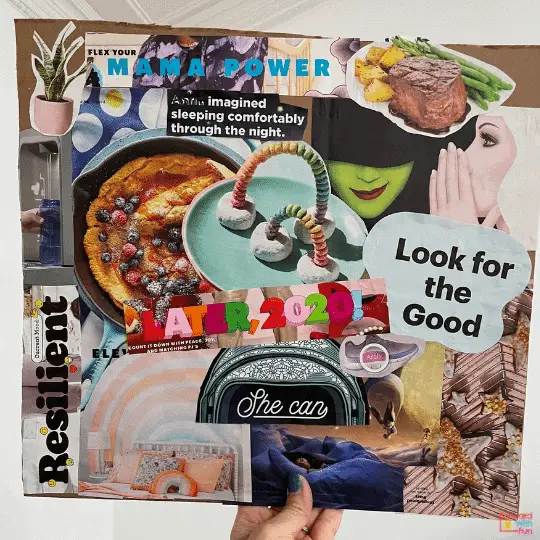
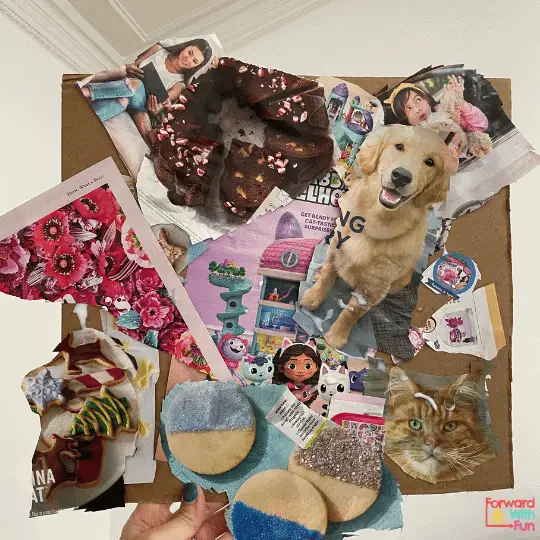
Kids might feel a little daunted by the task of creating a vision board when presented with the materials. Here are some questions to help guide them as they begin to search for what inspires them:
These questions will guide children to find pictures and words they are passionate about without having to set goals right away. That's the beauty of the whole project. The goals illuminate themselves once kids gather all their cut outs and put them together!
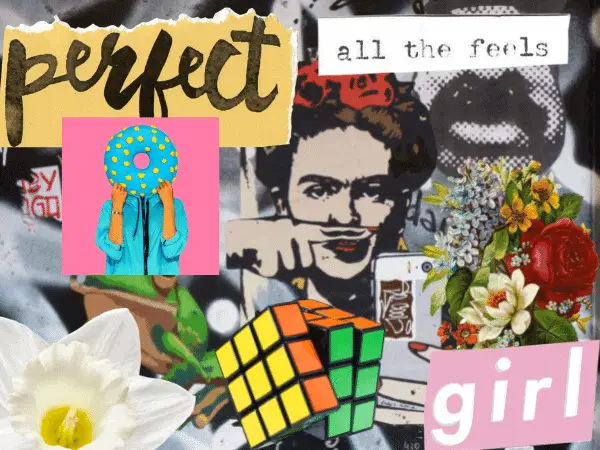
After the kids are done putting together their vision boards, that's the time when you can review and reflect on them with questions like...
I highly recommend displaying a vision board somewhere that you and your child will walk by frequently. We chose our kitchen window so that we will walk by it each day multiple times. Seeing the pictures gives us more intention as we go about our day and reminds us to take time out of our lives to pursue the passions and goals we set forth.
So, have your ever made a vision board? Have you ever thought about making vision boards for kids? Whether it's an at home or whole class project, you can't go wrong!